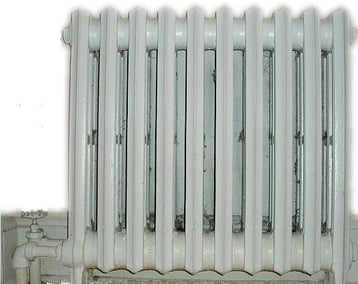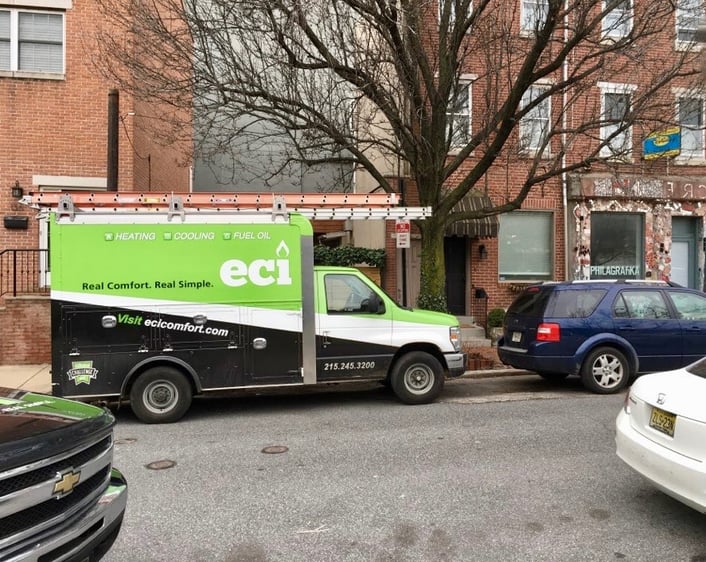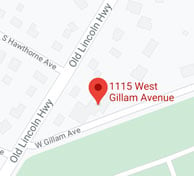The Old City section of Philadelphia is famous for its rowhomes, and those houses are equally famous for being uncomfortable in our humid summers.
Many of these homes are a century old, if not older, so they don’t have central heating and cooling systems. As a result, many folks rely on window units to try to stay comfortable in the heat. They’re not great, but for most people, they were the best solution...until mini-split air conditioning came along. That's why our homeowner called us a few years ago to make the upgrade.

Heating and Cooling a 1920s Rowhome

This rowhome, built in the 1920s, had a gas-fired water boiler and cast iron radiators for heat. As for central air, there was none.
If ductwork was being used for forced air heat, we could use that for AC as well; but radiators use pipes, meaning nothing was in place for traditional central air. For these homeowners (and many other rowhome owners) that meant relying on bulky window air conditioners for cooling. The drawback is that they’re a pain to install and take down seasonally, and they block up your windows for a good part of the year.
On top of that, window units are not very efficient -- they use more energy than central units. That means going through all the work of installing them just to end up with much higher electric bills in the summer.
The alternative would be trying to install central air, but that poses plenty of challenges, too. For one, we’d have to install ductwork, which takes up a lot of space. It would require building soffits, or enclosures, around it that are usually more than two feet wide and almost a foot deep. In a small rowhome, that’s a lot of space to take up in each room!
Fortunately, this homeowner had a mini-split system in his previous home. He knew how they worked and that the same type of system would make a big difference in his current home.
Mini-Split Versus Central Air
On the one hand, a mini-split system costs more to install compared to central air. However, there are ways to reduce that expense, and mini-split heat pump systems offer many more benefits.
Takes up less room
The mini-split system doesn’t need large ductwork to add both air conditioning and heat to a home. That gives us much more flexibility when placing the components. Additionally, the outdoor unit of a mini-split system (a heat pump) is smaller than the outdoor unit for traditional central air, so you're also saving room outside your home.
Lower monthly energy bills
Next, mini-splits like those from Mitsubishi are much more energy efficient than traditional air conditioners. Thanks to advanced heat pump technology and zoning (which we’ll get into in a moment), these systems use much less electricity. That means much lower electric bills, too.

Quieter cooling
That technology also has another benefit: silence. Mini-splits only produce about 20 decibels of sound. That’s compared to up to 70 decibels for central air. Another way to think about that is to compare the sound of leaves rustling versus a car 25 feet away passing by at 65 mph.
Zoned HVAC

Zoned HVAC is when we break up a home into different areas, or zones, with a separate air handler to treat each one. Each air handler also uses a separate thermostat, rather than one to control a whole house or floor.
With one thermostat for an entire house, it will shut off once the room that it's in reaches the desired temperature. But the rooms upstairs may not be where you want them, leaving you with colder rooms in the winter and hotter rooms in the summer.
With zoned HVAC, you’re measuring -- and treating -- each part of the house separately.
Installing a Ducted Heat Pump System in a 90-year-old Rowhome
In a rowhome like this, where there’s not a lot of extra space, we have to be creative. Fortunately, ECI Comfort has been installing mini-splits for years. We can fit them virtually anywhere without getting in the way.
Our first step here was installing the heat pump on the roof.
Again, the heat pump is the outdoor component. It’s similar to a traditional AC condenser, except it’s much smaller (and quieter). However, this property didn’t have a backyard or any room on the sides of the home to place the heat pump. So, up we went.

We can get up there easily enough for annual maintenance calls and the homeowner won’t have to do anything with it.
Next came the air handlers. The Mitsubishi Hyper-Heat heat pumps can work ducted or ductless. In this case, we installed a ducted system.
This home called for two mini-split units: one air handler in the laundry room and one in the small space in the attic above the stairwell. From there, we connected the air handlers to vents in the ceilings. For this home, we went with horizontal-ducted air handlers (left) versus a traditional ducted one (right) to save tons of room.

For an Old City rowhome like this, nothing could be better than an efficient, year-round comfort system. Mini-splits like this Hyper-Heat model can act as both air conditioning and heating, so now our homeowner can get a touch of heat on chilly Fall days without firing up the boiler and radiators.
The forced water system is still in place but the new heat pump system delivers more pinpointed heat quickly and efficiently. That’s a big difference when you consider how long a radiator can take to warm up a room. And, thanks to the new system’s energy efficiency, our homeowner gets more comfort with lower energy bills.
Then when the weather gets warm, he doesn’t worry about window AC units. There’s no more guessing when to install them or when to take them out. Plus, he’s never caught off-guard by an unexpected shift in the weather -- the mini-split is always ready to go.
Finally, the system increases the long-term value of the home as well. That means adding comfort to the air and money in our homeowner’s pocket.
If you live in the Delaware Valley/Greater Philadelphia area and would like to find comfort within your home, visit our website or give us a call at 215 - 245 - 3200 to learn more.







